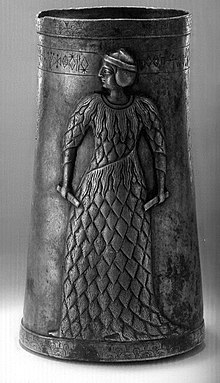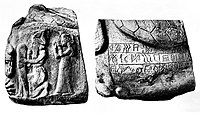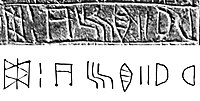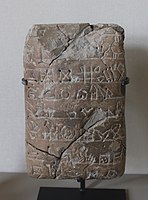Linear Elamite
| Linear Elamite | |
|---|---|
 List of known Linear Elamite characters.[1] | |
| Script type | Undeciphered
|
Time period | 3rd millennium BC |
| Status | Extinct |
| Direction | left-to-right |
| Languages | Elamite |
| Related scripts | |
Parent systems | Proto-writing
|
Linear Elamite is a Bronze Age writing system used in Elam between 2300-1850 BCE, known mainly from a few monumental inscriptions. It was used contemporaneously with Elamite cuneiform and possibly records the Elamite language.
Overview[]
It was in use for a brief period of time during the last quarter of the 3rd millennium BC. It is often claimed that Linear Elamite is a syllabic writing system derived from the older Proto-Elamite writing system, although this has not been proven. Linear Elamite has not been deciphered.[2]
There have been multiple attempts to decipher the script. Early efforts by (1912) and Ferdinand Bork (1924) made limited progress.[3] Later work by Walther Hinz and Piero Meriggi furthered the work.[4][5][6][7] In November 2020, announced that he has deciphered the script.[8] The article describing his discovery is to be published in 2021.
Demise[]
It is thought that the use of Linear Elamite ended circa 2100 BC with the death of King Kutik-Inshushinak, last ruler of the Awan Dynasty in Susa. After his death the linear script fell into disuse, and Susa was overrun by the Third dynasty of Ur, while Elam fell under control of the Shimashki dynasty (also Elamite of origin).[9]
Influences[]
Scholars have been comparing the Indus valley script with Linear Elamite, as the two languages were contemporary to each other. One of the best sources of knowledge regarding the Elamite language is a bilingual monument called the "Table of the Lion" currently in the Louvre museum. The monument is written in both Akkadian, which is a known language, and in Linear Elamite. On comparing this ancient language to the Indus script, a number of similar symbols have been found.[10]
Discovered texts[]
There are only 22 known documents in Linear Elamite; they are identified by letters A-V (Hinz, 1969, pp. 11–44; Andre‚ and Salvini, 1989, pp. 58–61); of these, 19 are on stone and clay objects excavated in the acropolis at Susa (now kept in the Louvre in Paris). Other objects are held at the National Museum of Iran.

The most important longer texts, partly bilingual, appear in monumental contexts. They are engraved on large stone sculptures, including a statue of the goddess Narunte (I), the "Table au Lion" (A), and large votive boulders (B, D), as well as on a series of steps (F, G, H, U) from a monumental stone stairway, where they alternated with steps bearing texts with Akkadian titles of Puzur-Inšušinak. A unique find is item Q, a silver vase with a single line of perfectly executed text, kept in the Tehran Museum. There are also a few texts on baked-clay cones (J, K, L), a clay disk (M), and clay tablets (N, O, R). Some objects (A, I, C) include both Linear Elamite and Akkadian cuneiform inscriptions. The bilingual and biographic inscriptions of the monumental stairway as a whole, and the votive boulder B have inspired the first attempts at decipherment of Linear Elamite (Bork, 1905, 1924; Frank, 1912). Nine texts have also been found on silver beakers (X, Y, Z, F’, H’, I’, J’, K’ and L’).[11] Note that some of the extant Linear Elamite inscriptions are suspected of being forgeries.
In 2016, 10 additional Linear Elamite inscriptions were discovered, some containing nearly 200 signs. [12]
Examples[]


Perforated stone, with Linear Elamite text. Louvre Museum Sb6 Sb177

Perforated stone proposed reading (1912).

Table au Lion, a proposed reading of the Linear Elamite (1912).

The Elamite name of Puzur-Inshushinak: 
Pu-zu-r Šu-ši-na-k
in Linear Elamite script.[15]
Clay tablet with Linear Elamite text. Louvre Museum Sb 9382.

Clay cone with Linear Elamite text. Louvre Museum Sb 17830. Reign of Puzur-Inshushinak.[16]
Decipherment[]
A very large Elamite language vocabulary is known from the trilingual Behistun inscription and numerous other bilingual or trilingual inscriptions of the Achaemenid Empire, in which Elamite was written using Elamite cuneiform (circa 400 BCE), which is fully deciphered. An important dictionary of the Elamite language, the Elamisches Wörterbuch was published in 1987 by W. Hinz and H. Koch.[17][18] The Linear Elamite script however, one of the scripts used to transcribe the Elamite language circa 2000 BCE, has remained elusive.[19]
First readings (1905-1912)[]

The first readings were determined by the analysis of the bilingual Cuneiform Akkadian-Linear Elamite Table au Lion (Louvre Museum), by Bork (1905) and Frank (1912). Two words with similar endings were identified in the beginning of the inscription in the known Akkadian Cuneiform (the words "Inshushinak"





